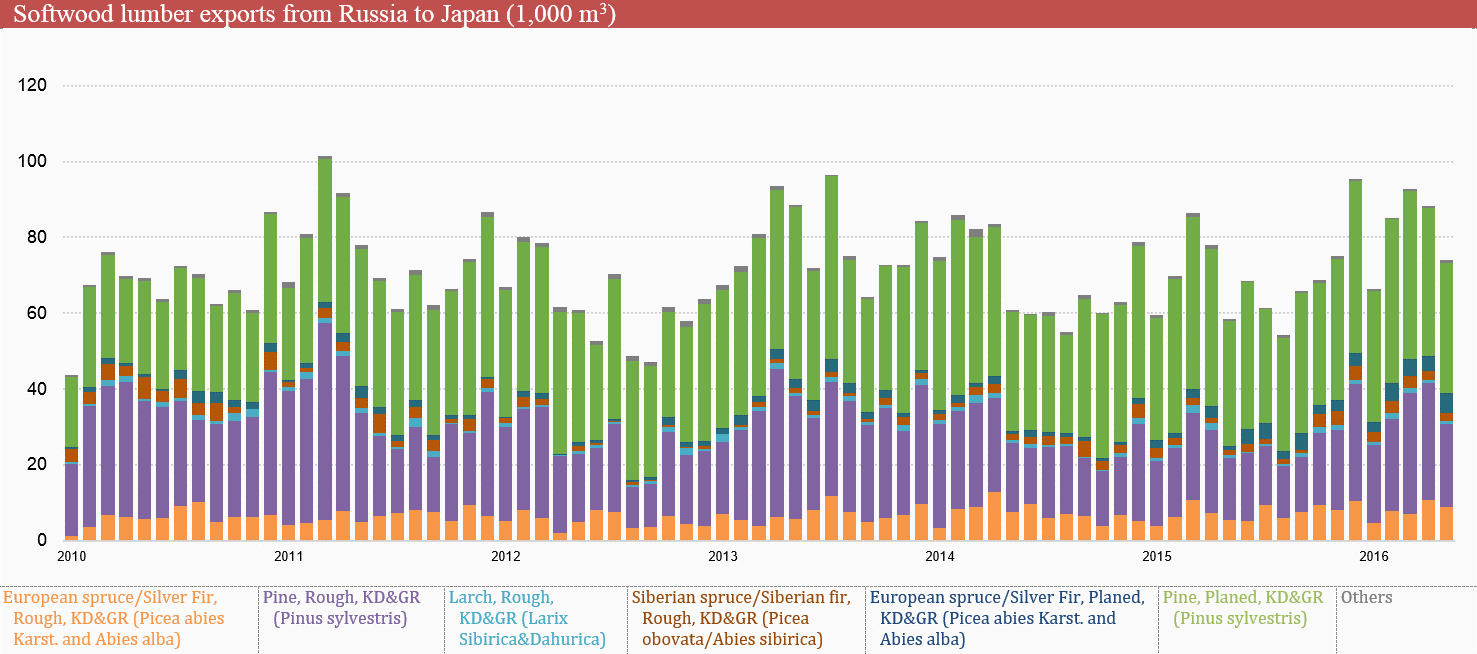Global lumber markets are on the rise
In Q1 of 2016, world trade of lumber increased by 20% (y-to-y). Ten largest importing countries – especially the US, China and Egypt – have increased the volume of purchases. In the period from January to April 2016, the United States imported lumber by 42% more than in the same period of 2015. China increased its import from Russia by 33% (y-to-y) and Canada by 4% (y-to-y). In May 2016, demand for Russian lumber remained stable in all key markets.
Russian softwood lumber sales volumes to European market decreased by 14% in May 2016 (m-to-m), but remained higher by 9.2% (y-to-y) at 286,000 m3. Estonia remained the largest importer of Russian lumber with a volume of 50,800 m3: +16% (y-to-y) and -14% (m-to-m). For 5 months of 2016, sales of Russian softwood lumber to the European market grew by 7.9% to 1.4 million m3.
In May 2016, export of Russian softwood lumber to Japan amounted to 74,000 m3 (-16% m-to-m and +26.6% y-to-y). For 5 months of 2016 export reached 407,000 m3 (+15% y-to-y).
Source: June 30, 2016 | Issue №10 — May 2016
In May 2016, industrial production growth in China remained at the level of 6% (y-to-y), despite the transition of the extractive industries to lower annual rate of growth. Retail sales growth slowed down slightly to 10% (y-to-y). Construction activity has reduced, but remains on the rise. Import proved to be at the level of the previous year (in dollar terms it amounted to -0.4% y-to-y after -10.9% y-to-y in April). Generally, this indicates a stabilization of the situation in the economy. Monthly assessment of economic growth in China in May remained at the April’s level (6.9% y-to-y, according to Bloomberg). In many respects this is a result of the stimulus measures taken by the authorities. However, the dynamics of loans and investments indicates a higher probability of rapid exhaustion of the effect of these measures. The growth of debt financing of the private sector in May continued to slow down from 12.1% to 11.5% y-to-y. In May 2016, supply from Russia to China rose again, but its pace noticeably decreased: + 1.4% (m-to-m) to 1.34 million m3, that is 57.8% more than in May 2015. For 5 months of 2016, Russian softwood lumber sales reached 5.3 million m3 (+38% y-to-y).
Export of Russian softwood lumber to the MENA region (Iran, Iraq, Israel, Jordan, Lebanon, Libya, Morocco, Syria, Egypt, Tunisia) in May 2016 amounted to 212,000 m3 (-14.6% m-to-m and -16.1% y-to-y). For 5 months of 2016, the volume reached 1,100 m3 (-15% y-to-y). Egypt, the biggest consumer of Russian softwood lumber in region (65% of the total), shortened down its import for the second month in a row. In May 2016, Russian import of softwood lumber fell by 4% (m-to-m) to 138,000 m3, on an annualized basis decline amounted to 17%. Iran, the second largest country in the region by its volume of import decreased deliveries by 38% (m-to-m), and by 23% (y-to-y) amounting to 53,900 m3. Early onset of Ramadan exerted influence to demand weakening.
CIS countries (excluding Belarus, Kyrgyzstan, Kazakhstan, Armenia) imported from Russia 316,000 m3 of softwood lumber (-2.8% m-to-m and +10% y-to-y) in May 2016. For 5 months of 2016, total volume of export amounted to 1,300 m3 (-25% y-to-y). Average selling price of Russian lumber manufacturers in May 2016 amounted to RUB 10,378 per m3 (+0.3% m-to-m). During the sale to the internal market: 6.020 RUB/m3 (-2.2% m-to-m) and 11.224 RUB/m3 (+0.7% m-to-m) during the export sales.
Total volume of export of softwood lumber from Russia in May 2016 amounted to 2.34 million m3 (+32% m-to-m and -3.8% y-to-y) with the total cost of $ 258 million (+10.7% m-to-m and -7.8% y-to-y). For 5 months of 2016, volume of export from Russia amounted to 10 million m3 (+11% y-to-y) worth of $ 1.14 billion (-4.6%).
Detailed report on the Russian softwood lumber export markets is given in the latest issue of our WhatWood Monthly Lumber Report.
 Timber industry research & analytics
Timber industry research & analytics 
